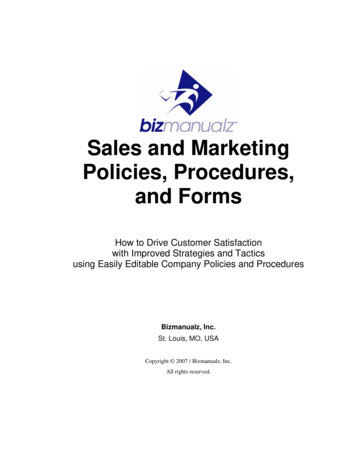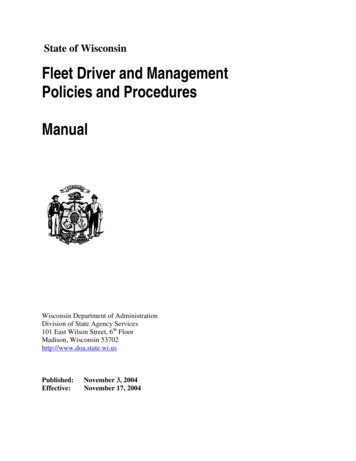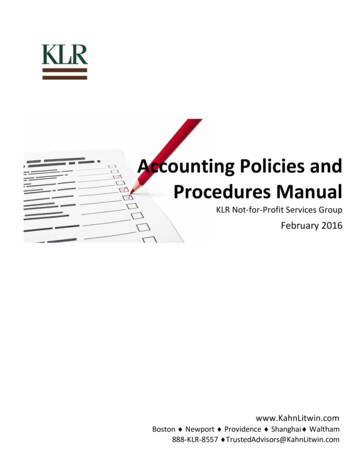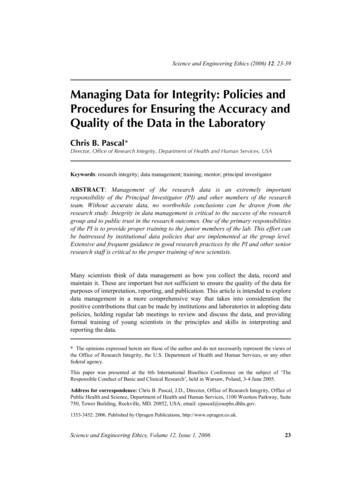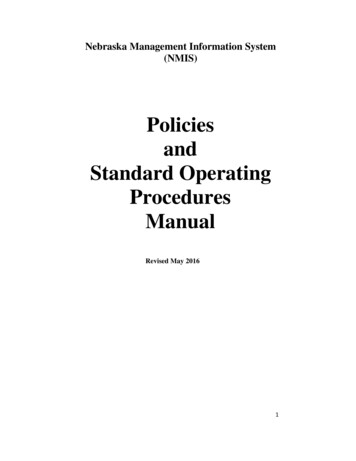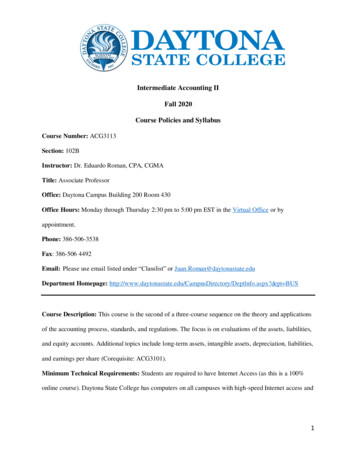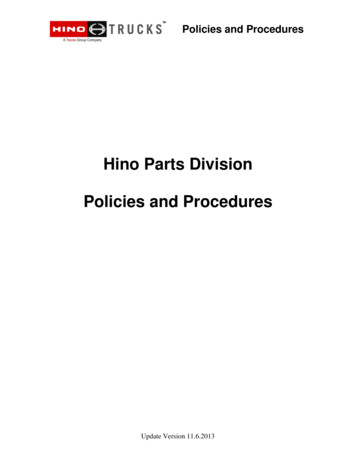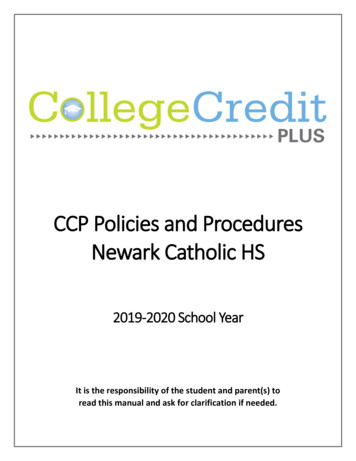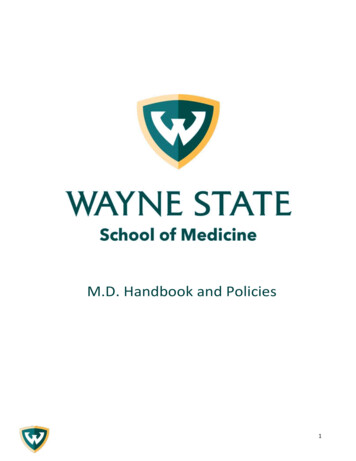
Transcription
M.D. Handbook and Policies1
Please note that information contained herein is subject to change during the course of any academic year.Wayne State University School of Medicine (WSUSOM) reserves the right to make changes including, but notlimited to, changes in policies, course offerings, and student requirements. This document should not beconstrued in any way as forming the basis of a contract. The WSUSOM Medicine M.D. Handbook and Policiesis typically updated yearly, although periodic mid-year updates may occur when deemed necessary. Unlikedegree requirements, changes in regulations, policies and procedures are immediate and supersede those inany prior Medical Student Handbook. The most current version of the WSUSOM of Medicine M.D. Handbookand Policies can always be found on the School of Medicine website.UPDATED 03.26.2021UNDERGRADUATE MEDICAL EDUCATION MAJOR COMMITTEES Admissions Committee Curriculum Committee Institutional Effectiveness Committee Professionalism Committee Promotions Committee2
DOCUMENT OUTLINE1. GENERAL STANDARDS1.1 NEW INSTITUTIONAL DOMAINS OF COMPETENCY AND COMPETENCIES Domain 1: Knowledge for Practice (KP) Domain 2: Patient Care (PC) Domain 3: Practice-Based Learning and Improvement (PBLI) Domain 4: Interpersonal and Communication Skills (ICS) Domain 5: Professionalism (P) Domain 6: Systems-Based Practice (SBP) Domain 7: Interprofessional Collaboration (IPC) Domain 8: Personal and Professional Development (PPD) Domain 13: Entrustable Professional Activities for Entering Residency1.2 SPECIFICATION OF REQUIREMENTS FOR GRADUATION1.3 WSUSOM TECHNICAL STANDARDS Observation Communication Motor skills Intellectual-conceptual (integrative and quantitative) abilities Behavioral and social attributes3
2. MD REQUIREMENTS AND PROCEDURES2.1STUDENT CONFIDENTIALITY AND ACCESS TO SENSITIVE INFORMATION Purpose Confidentiality Rights Under FERPA for Postsecondary Institutions Student Information and Academic Records Review and Amend Records2.2DATA SECURITY AND PRIVACY (HIPAA) - Pending2.3DEFINITION OF MEDICAL STUDENT PRACTICE ROLE2.4STUDENT DISABILITY SERVICES2.5RESEARCH INTERGRITY2.6EVALUATION COMPLETION REQUIREMENTS Segment 3 and Segment 4 Clerkship and Elective Grading Mid-clerkship Evaluations Grading Written Examinations Clinical Performance Evaluation2.7TRANSCRIPT GRADING KEY2.8LEAVES OF ABSENCE AND DISCONTINUATION AND REINSTATEMENT2.9MALPRACTICE LIABILITY FOR MEDICAL STUDENTS2.10 HEALTH AND DISABILITY INSURANCE2.11 MEDICAL HEALTH REQUIREMENTS AND IMMUNIZATIONS Compliance with Health Standards Required Communicable Disease Vaccinations Required Vaccinations/Evidence of Immunity Policy Required Documentation of Vaccinations and Evidence of Immunity Annual Influenza Vaccination Policy Annual TB Screening Policy2.12 COMPUTER AND DEVICE SECURITY4
2.13 MISTREATMENT POLICY Student Mistreatment Examples of Mistreatment Reporting Mistreatment Rights of the Accuser and Accused Wayne State University’s Nondiscrimination Policy Statement Responding to Concerns of Mistreatment No Retaliation2.14 SAFETY TRAINING2.15 WSUSOM POLICY FOR THE REMOVAL AND TRANSPORT OF PHI – Pending2.16 WSUSOM EDUCATION RESEARCH POLICY2.17 STEPPING OUT OF THE MD CURRICULUM SEQUENCE – Pending2.18 UNIVERSAL PRECAUTIONS AND NEEDLESTICK PROTOCOL2.19 USMLE REQUIREMENTS: STEP 1, STEP 2 CK AND STEP 2CS2.20 SEGMENT 1 & 2 ELECTIVES2.21 ABSENCE POLICY AND EXPECTATIONS Excused Absences Limit On Number Of Excused Absences Illness Religious Holidays2.22 N95 RESPIRATOR MASK FIT REQUIREMENTS FOR MEDICAL STUDENTS2.23 WSUSOM DRESS CODE2.24 WSUSOM CRIMINAL BACKGROUND CHECK POLICY Criminal Background Check and Michigan Public Sex Offender Registry Check Guidelines Purpose Policy Process5
2.25 ENROLLMENT STATUS POLICIES Enrollment Status Dismissal Withdrawal Leaves of Absence Special Matriculation Eligibility to Participate in Educational Programs Prohibition from Participation in School Activities Dis-enrollment from Coursework Seven-Year Limit to Complete All Degree Requirements Eligibility for Federal Financial Aid: Satisfactory Academic Progress Title IV Disbursement Issues and Financial Aid Probation2.26MEDICAL EDUCATION GUIDE TO STUDENT SERVICES6
3. CURRICULUM3.1 WSU SOM EVALUATION OF CURRICULUM POLICY3.2 CURRICULUM SCHEMATIC3.3 ACADEMIC CALENDAR3.4 ACADEMIC REQUIREMENTS FOR GRADUATION – Pending3.5 SCHOLARLY CONCENTRATION REQUIREMENT – Pending4. ASSESSMENT OF STUDENT ACADEMIC PERFORMANCE4.1 HEALTH PROVIDER INVOLVEMENT IN STUDENT ASSESSMENT4.2 EVALUATION OF PERFORMANCE IN COURSES Segment 1-2 Assessment Policies Segment 1-2 Basic Science Curriculum Assessments Population, Patient, Physician and Professionalism/Service-Learning Course Assessments Clinical Skills Course Assessments Segment 1-2 Attendance Policy End of Segment 1-2 Comprehensive Scores End of Segment 1-2 Commendations/Honors Remediation and Re-Examination Policy Appeal of Grades Academic Probation4.3 TESTING POLICIES Examination Policies (Segment 1 – 4) Absence from an exam (Segment 1 – 4) Make-up Examinations (Segment 1 – 4) Post Exam Review Process (Segment 1 – 2 ) Disruptive Behavior During Examinations (Segment 1 – 4) Academic Misconduct (Segment 1 – 4) Completion of Courses in a Timely Manner (Segment 1 – 2) Testing Accommodations for Students with Disabilities (Segment 1 – 4) Other Examination Policies (Segment 1 – 4)4.4 STANDARDIZED PATIENT TEACHING AND ASSESSMENT – Pending4.5 MEDICAL STUDENT PERFORMANCE EVALUATION (MSPE)4.6 PROMOTIONS POLICIES7
5. PERFORMANCE, PROFESSIONALISM, AND PROMOTION5.1 PROFESSIONALSIM POLICY OVERVIEW5.2 GENERAL POLICY ON VIOLATION OF WSUSOM PROFESSIONALISM STANDARDS5.3 REPORTING PROCESS5.4 PROCESSES FOR CLINICAL ROTATIONS5.5 DOMAINS OF PROFESSIONAL BEHAVIOR5.6 SOCIAL MEDIA POLICY6. TUITION AND FINANCIAL AID6.1 TUITION STRUCTURE AND BUDGET6.2 UNIVERSITY BILLING6.3 FINANCIAL AID8
7. WAYNE STATE UNIVERSITY POLICIES7.1WAYNE STATE UNIVERSITY POLICIES7.2NONDISCRIMINATION POLICY7.3COMMUNITY STANDARDS7.4PROHIBITED SEXUAL CONDUCT7.5CONSENSUAL SEXUAL OR ROMANTIC RELATIONSHIPS IN THE WORKPLACE AND EDUCATIONALSETTING7.6STUDENT ACADEMIC GRIEVANCE PROCEDURE7.7CHILDBIRTH ACCOMODATION POLICY FOR WOMEN GRADUATE STUDENTS AT WSUSOM7.8OWNERSHIP AND USE OF WAYNE STATE UNIVERSITY NAMES AND TRADEMARKS7.9ACCEPTABLE USE OF INFORMATION TECHNOLOGY RESOURCES7.10 SMOKE-FREE ENVIRONMENT7.11 CAMPUS SAFETY AND CRIMINAL STATISTICS7.12 MICHIGAN DEPARTMENT OF CONSUMER AFFAIRS COMPLAINT PROCEDURE7.13 WAYNE STATE UNIVERSITY BOARD OF GOVERNORS DRUG AND ALCOHOL ABUSE ONCAMPUS POLICY7.14 ROLE OF MEDICAL STUDENTS7.15 SNOW DAY7.16 OFFICIAL COMMUNICATION9
SEGMENT 3 CLERKSHIP POLICIES8. SEGMENT 3 CLERKSHIP POLICIES8.1 MANDATORY ATTENDANCE POLICY FOR CLERKSHIP ORIENTATIONS8.2 SCHEDULE AND SITE CHANGES FOR ADMINISTRATIVE OR EDUCATIONAL REASONS8.3 ENTRANCE TO SEGMENT 38.4 CLINICAL READINESS ASSESSMENT CRA POLICY Structure of Program Content of CRA Limited Space Keeping Us Apprised of Your Plans8.5 PROMOTION TO SEGMENT 3 Deadlines for Posting USMLE STEP 1 Scores in Order to Begin a Clerkship8.6 SEGMENT 3 ORIENTATION8.7 EVALUATION, GRADING & PROMOTION POLICIES FOR CLERKSHIPS & ELECTIVES8.8 MID-CLERKSHIP EVALUATIONS8.9 SEGMENT 3 EXAMINATIONS Examination Policies Grading Examinations8.10 WSUSOM SEGMENT 3 CLERKSHIP NBME SUBJECT EXAM GRADING POLICY8.11 CLINICAL PERFORMANCE EVALUATION AND GRADE REPORT FORMS8.12 GRADING POLICIES Determination of Clerkship Final Clinical Evaluations Requirement to Complete All Clerkship Assignments Clinical Encounters and Procedures Requirement Deadline for Logging8.13 DETERMINATION OF FINAL CLERKSHIP GRADES8.14 REPORTING CLERKSHIP GRADES8.15 CRITERIA FOR AWARDING SEGMENT 3 HONORS10
8.16 REMEDIATION OF FAILED EXAMINATIONS One Failed Exam Two Failed Exams Repeat Exams During Clerkships Scoring8.17 REMEDIATION OF FAILED CLINICAL WORK OR FAILED COURSES8.18 OVERALL COMPARATIVE PERFORMANCE IN MEDICAL SCHOOL (SEGMENTS 1-3)8.19 GRADE APPEALS8.20 ACADEMIC PROBATION DURING SEGMENT 38.21 STUDENT RESPONSIBILITY AND REQUIRED EXPERIENCE TRACKING ANDCLERKSHIP/ELECTIVE EVALUATIONS8.22 NEEDLESTICKS AND OTHER EXPOSURE TO BODY FLUIDS8.23 PARKING AT ASSIGNED HOSPITALS8.24 REQUESTS FOR EXCUSED ABSENCES FOR RELIGIOUS HOLIDAYS AND OTHERABSENCES8.25 CHANGES TO THESE CURRICULUM GUIDELINES8.26 DUTY HOURS On-Call Activities Reporting of Duty Hours Violations8.27 OTHER IMPORTANT INFORMATION11
SEGMENT 4 POLICIES9. SEGMENT 4 POLICIES AND PROCEDURES9.1OVERVIEW OF THE SEGMENT 4 CLINICAL CURRICULUM9.2PROMOTION OF SEGMENT 3 STUDENTS TO SEGMENT 4 (SENIOR) STATUS9.3THE SEGMENT 4 SCHEDULING PROCESS9.4GENERAL POLICIES, SENIOR COURSE REQUIREMENTS AND SENIOR PROGRAM SCHEDULING9.5COURSE CHANGES: ADD/DROPS9.6CHANGING A SEGMENT 4 ELECTIVE9.7REQUIRED SENIOR CLERKSHIPS9.8SPECIAL OR RESTRICTED SEGMENT 4 PROGRAMS9.9USMLE STEP 2CK AND STEP 2CS9.10 TIME OFF FOR RESIDENCY INTERVIEWS9.11 ISSUES WITH AWAY ELECTIVES9.12 GRADES IN SENIOR COURSES Grade Appeals9.13 ELECTIVES Away and Home ElectivesApplying for Away ElectivesIndependent Study ElectivesElective GradesInternational Electives9.14 STUDENT RESPONSIBILITY AND CLERKSHIP/ELECTIVE EVALUATIONS9.15 PARKING AT ASSIGNED HOSPITALS9.16 REQUESTS FOR EXCUSED ABSENCES FOR RELIGIOUS HOLIDAYS AND OTHER ABSENCES9.17 OTHER IMPORTANT INFORMATION12
1. GENERAL STANDARDSIn this section:1.1NEW INSTITUTIONAL DOMAINS OF COMPETENCY AND COMPETENCIES1.2SPECIFICATION OF REQUIREMENTS FOR GRADUATION1.3WSUSOM TECHNICAL STANDARDS13
1.1NEW INSTITUTIONAL DOMAINS OF COMPETENCY AND COMPETENCIESIn 2016, Wayne State University School of Medicine analyzed the current institutional learning objectives anddecided to revise its competency domains and related competencies for the program leading to the MDdegree. As a result, the new AAMC domains of competency were assumed and many institutionalcompetencies changed; in some areas, the previous WSUSOM competencies were maintained but mapped toa Physician Competency Reference Set competency and in other areas the new PCRS competencies wereadopted. The new domains and competencies are intended to be in line with the AAMC’s PCRS and to map thecompetencies to the Entrustable Professional Activities. WSUSOM Undergraduate Medical EducationCurriculum Committee approved the competency domains and competencies on 6/8/2016; they wereinstituted beginning with the 2016-2017 academic year.DOMAIN 1: KNOWLEDGE FOR PRACTICE (KP)Demonstrate knowledge of established and evolving biomedical, clinical, epidemiological, and socialbehavioral sciences, as well as the application of this knowledge to patient renceto thePCRSEPA 1, 3, 13EPA 2KP 1KP 2EPA 2, 7KP 3EPA 2, 3, 7KP 4KP 5KP 6WSUSOM CompetencyKP 1: Demonstrate an investigatory and analytic approach to clinical situationsKP 2: Apply established and emerging biophysical scientific principles fundamental tohealth care for patients and populationsKP 3: Apply established and emerging principles of clinical sciences to diagnostic andtherapeutic decision making, clinical problem solving, and other aspects of evidencebased health careKP 4: Apply principles of epidemiological sciences to the identification of healthproblems, risk factors, treatment strategies, resources, and disease prevention/healthpromotion efforts for patients and populations*KP 5: Apply psychosocial principles and concepts in the delivery of health care, includingassessment of the impact of psychosocial-cultural influences on health, disease, careseeking, care-compliance, and barriers to and attitudes toward care*KP 6: Contribute to the creation, dissemination, application, and translation of new healthcare knowledge and practices* Represents a WSUSOM Undergraduate Medical Education mission based competency toward urbanclinical excellence.14
DOMAIN 2: PATIENT CARE (PC)Provide patient-centered care that is compassionate, appropriate, and effective for the treatment of healthproblems and the promotion of ferenceto thePCRSWSUSOM CompetencyEPA 10, 12PC 1PC 1: Perform routine technical procedures specified by the medical school andclerkshipEPA 1, 2, 4, 6,10EPA 1, 2, 4, 6,10PC 2PC 2PC 2A: Take a satisfactory medical history including psychosocial, nutritional,occupational and sexual dimensionsPC 2B: Perform a satisfactory physical examEPA 1, 2, 4, 6,10EPA 10, 11PC 2PC 2C: Accurately document the clinical encounterPC 3PC 3: Apply the concepts and principles of patient safety science in the delivery ofclinical careEPA 2, 3, 5, 10PC 4EPA 2, 3, 5, 10PC 4PC 4A: Apply laboratory and imaging methods in identifying diseases or healthproblemsPC 4B: Interpret laboratory data, imaging studies, and other tests required for thearea of practiceEPA 3, 4, 10PC 5EPA 3, 4, 10PC 5EPA 4, 5, 10,11PC 6PC 6A: Formulate effective management plans (diagnostic, treatment, preventionstrategies, including relieving pain and ameliorating the suffering of patients) fordiseases and other health problemsEPA 4, 5, 10,11PC 6PC 6B: Monitor the course of illnesses and to appropriately revise the managementplanEPA 3, 11, 12PC 7PC 7: Counsel and educate patients and their families to empower them toparticipate in their care and enable shared decision making*EPA 8PC 8PC 8: Understand the need and value of consultations and referrals in the delivery ofhealth careEPA 3PC 9PC 9: Apply preventive and health maintenance principles and techniques in thedelivery of health care*PC 10PC 10: Provide appropriate role modelingPC 11PC 11: Perform supervisory responsibilities commensurate with one’s roles, abilities,and qualificationsPC 12: Diagnose and manage patients with common diseases and health-relatedconditions prevalent in urban settings*PC 12PC 5A: Utilize data from the history, physical exam and laboratory evaluations, withup-to-date scientific evidence to identify health problemsPC 5B: Formulate an appropriate differential diagnosis* Represents a WSUSOM Undergraduate Medical Education mission based competency toward urban clinicalexcellence.15
DOMAIN 3: PRACTICE-BASED LEARNING AND IMPROVEMENT (PBLI)Demonstrate the ability to investigate and evaluate one’s care of patients, to appraise and assimilatescientific evidence, and to continuously improve patient care based on constant self-evaluation and ctivitiesEPA 2, 4, 6, 7Referenceto thePCRSWSUSOM CompetencyPBLI 1PBLI 1: Recognize personal educational needs and to select and utilizeappropriate resources to optimize learningPBLI 2PBLI 2: Set learning and improvement goalsEPA 7PBLI 3PBLI 3: Identify and perform learning activities that address one’s gaps inknowledge, skills, or attitudesEPA 13PBLI 4PBLI 4: Systematically analyze practice using quality-improvement methods andimplement changes with the goal of practice improvementEPA 8PBLI 5PBLI 5: Incorporate feedback into daily practiceEPA 7PBLI 6PBLI 6: Locate, appraise, and assimilate evidence from scientific studies related topatients’ health problemsEPA 4, 7, 8PBLI 7PBLI 7: Use information technology to optimize learningPBLI 8PBLI 8: Participate in the education of patients, families, students, trainees,peers, and other health professionalsPBLI 9PBLI 9: Obtain and utilize information about individual patients, populations ofpatients, or communities from which patients are drawn to improve care*EPA 3, 7* Represents a WSUSOM Undergraduate Medical Education mission based competency toward urbanclinical excellence.16
DOMAIN 4: INTERPERSONAL AND COMMUNICATION SKILLS (ICS)Demonstrate interpersonal and communication skills that result in the effective exchange of informationand collaboration with patients, their families, and health itiesReferenceto thePCRSWSUSOM CompetencyEPA 1, 4, 5, 6,11ICS 1ICS 1: Effectively interact with patients, peers, families and other healthcareworkers from diverse cultural backgrounds*EPA 2, 5, 6, 7,8, 9, 10, 13ICS 2ICS 2: The ability to effectively communicate with peers and members of thehealthcare team in the care of patients and their familiesEPA 8, 9ICS 3ICS 3: The ability to work cooperatively with other health care workers in thedelivery of health careICS 4ICS 4: Act in a consultative role to other health professionalsEPA 5, 11, 12ICS 5ICS 5: Maintain comprehensive, timely, and legible medical recordsEPA 10, 12ICS 6ICS 6: Demonstrate sensitivity, honesty, and compassion in difficult conversations(e.g. about issues such as death, end-of-life issues, adverse events, bad news,disclosure of errors, and other sensitive topicsEPA 1, 9, 11ICS 7ICS 7: Demonstrate insight and understanding about emotions and humanresponses to emotions that allow one to develop and manage interpersonalinteractions* Represents a WSUSOM Undergraduate Medical Education mission based competency toward urbanclinical excellence.17
DOMAIN 5: PROFESSIONALISM (P)Demonstrate a commitment to carrying out professional responsibilities and an adherence to ethical esEPA 1, 6, 9Referenceto thePCRSWSUSOM CompetencyP1P 1: Demonstrate compassion, integrity, and respect for others, in particularpeople from vulnerable population*P2P 2: Demonstrate responsiveness to patient needs that supersedes self-interestEPA 1, 6, 8P3P 3 Respect the patients’ dignity, privacy, and confidentiality in the delivery ofhealth careEPA 5, 13P4P 4: Demonstrate accountability to peers, patients, society, and the professionEPA 1P5P 5: Demonstrate sensitivity and responsiveness to diverse populations, includingbut not limited to diversity in gender, age, culture, race, religion, disabilities, andsexual orientation*EPA 12P6P 6: Demonstrate a commitment to ethical principles pertaining to provision orwithholding of care, confidentiality, informed consent, and business practices,including compliance with relevant laws, policies, and regulationsP7P 7: Demonstrate credibility, initiative, integrity and professional competenceneeded to gain the confidence and respect of others while providing clinicalcare or other services to diverse populations in an urban setting** Represents a WSUSOM Undergraduate Medical Education mission based competency toward urbanclinical excellence.18
DOMAIN 6: SYSTEMS-BASED PRACTICE (SBP)Demonstrate an awareness of and responsiveness to the larger context and system of health care, as well asthe ability to call effectively on other resources in the system to provide optimal health renceto thePCRSWSUSOM CompetencyEPA 5SBP 1SBP 1: Describe the health care delivery systems including social, economic andpolitical dimensionsEPA 9SBP 2SBP 2: Coordinate patient care within the health care system relevant to one’sclinical specialtyEPA 3, 4, 11,12SBP 3SBP 3: Incorporate considerations of cost awareness and risk-benefit analysis inpatient and/or population based care*EPA 13SBP 4SBP 4: Advocate for quality patient care and optimal patient care systems tosupport and contribute to a culture of safetyEPA 13SBP 5SBP 5: Participate in identifying system errors and implementing potentialsystems solutionSBP 6SBP 6: Perform administrative and practice management responsibilitiescommensurate with one’s role, abilities, and qualificationsSBP 1SBP 1: Describe the health care delivery systems including social, economic andpolitical dimensionsEPA 5* Represents a WSUSOM Undergraduate Medical Education mission based competency toward urbanclinical excellence.19
DOMAIN 7: INTERPROFESSIONAL COLLABORATION (IPC)Demonstrate the ability to engage in an inter-professional team in a manner that optimizes safe,effective patient and population-centered renceto thePCRSWSUSOM CompetencyEPA 9IPC 1IPC 1: Work with other health professionals to esta
Mar 26, 2021 · 9.8 SPECIAL OR RESTRICTED SEGMENT 4 PROGRAMS 9.9 USMLE STEP 2CK AND STEP 2CS 9.10 TIME OFF FOR RESIDENCY INTERVIEWS 9.11 ISSUES WITH AWAY ELECTIVES 9.12 GRADES IN SENIOR COURSES Grade Appeals 9.13 ELECTIVES Away and Home Electives Applying for Away

